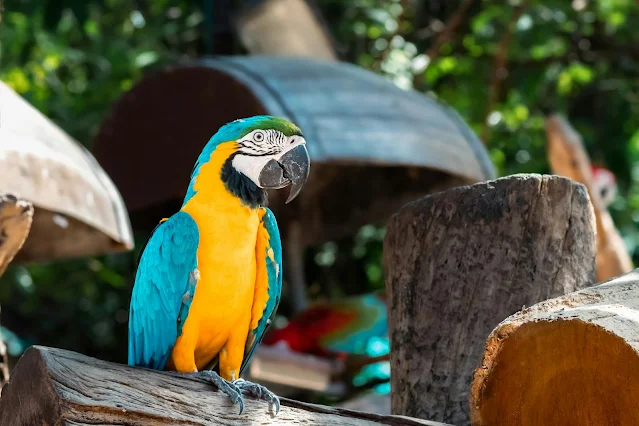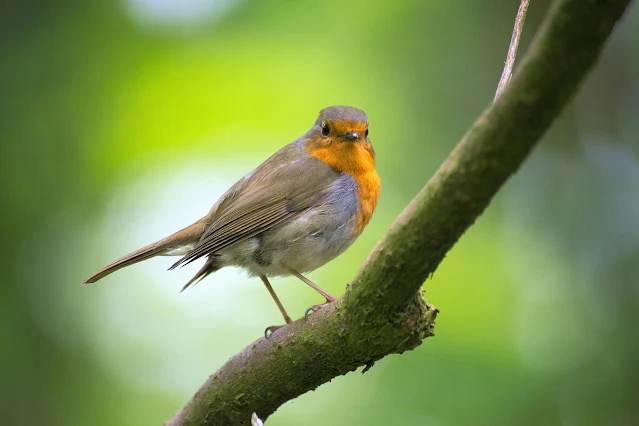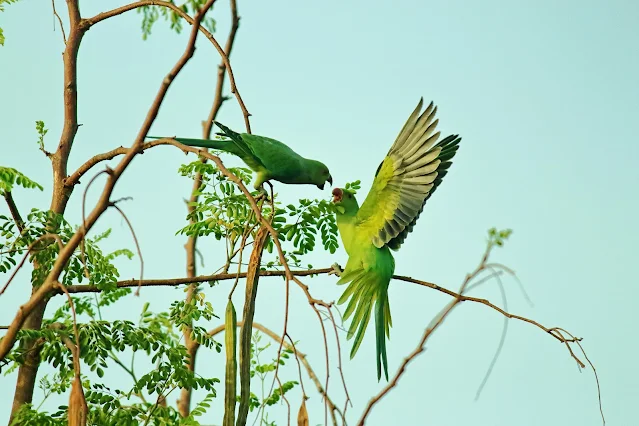The Global Bird Market: Is the Pet Bird Business Worth it?
Without a doubt, dogs and cats have always been the go-to choice for pet lovers everywhere. However, as interest in exotic pets continues to rise, more and more people are opting for these unique companions. For example, birds, representing the exotic pet category, are experiencing a steady surge in ownership, inadvertently driving the growth of the bird market, including products and services related to avian care.
Global Bird Market Segmentation and Market Size
Birds Market Segmentation
The bird market is typically divided into domestic and wild birds (also known as outdoor birds).
1. Domestic Birds
Mainly refers to birds bred and raised through artificial means, including various species of parrots, pigeons, and even ostriches. These birds are often kept as pets or supplied for commercial purposes to zoos, exhibitions, etc. Due to the controlled breeding and management of domestic birds, their numbers and quality are relatively stable, and market prices are more transparent.
2. Wild Birds
All birds other than poultry (such as chickens, ducks, geese, guinea fowls, peacocks, and turkeys), members of the Psittacidae family (such as parrots and lovebirds), and other exotic cage birds (such as common canaries, foreign finches, and doves). The numbers of these birds are limited and subject to legal restrictions, resulting in relatively higher market prices and greater market volatility.
Global Market Perspective
While pet owners cherish the birds they keep at home, an increasing number of people are becoming enamored with birds living outdoors. More individuals are beginning to feed and care for wild birds in their communities. Caring for domestic pet birds differs significantly from looking after wild birds since the latter are self-sufficient.
1. Bird Food Market Size
As the largest category of bird demand, its development prospects are very promising. According to the latest research from Future Market Insights (FMI), the global bird food market was estimated to be around $2.1 billion in 2022, projected to reach $3 billion by 2032.
2. Compound Annual Growth Rate (CAGR) of the Bird Food Market
FMI's report indicates that from 2022 to 2032, the global bird food market is expected to grow at a compound annual growth rate of 3.6%. The bird food market's share of the pet care market is estimated to be between 1.5% and 2.5%.
An important trend worth noting is that wild birds are occupying an increasingly larger share of the market.
3. Wild Bird Market Size
According to data from the market research company Introspective Market Research (IMR), the global market for wild bird products is expected to grow from $5.2 billion in 2022 to $6.89 billion by 2030.
4. Compound Annual Growth Rate (CAGR) of the Wild Bird Market
IMR forecasts a compound annual growth rate of 3.58% during the forecast period (2023-2030), while FMI's latest data reveals a compound annual growth rate of 3.8% during the forecast period (2023-2033). Overall, while there are some differences in statistical dimensions, both reports provide comparable data, offering valuable insights into the market trends.
Breaking Down the Market by Region
Countries like the USA in North America, Italy in Europe, Brazil in Latin America, China in Asia Pacific, and Indonesia in Southeast Asia are leading the pack when it comes to pet bird and wild bird populations. The market demand in these regions is steadily increasing. (Specific data will be detailed below.)
Let's take a closer look at the United States, Italy, China, Brazil, and Indonesia.
1. United States
This region remains one of the most profitable markets globally for bird products, including both domestic and wild birds. Americans have a particular fascination with wild birds, with bird feeder products being especially popular, particularly visually appealing ones. According to local media reports, sales of feeders, seeds, and most bird-related products see significant spikes at the beginning of each year, partly due to birdwatching enthusiasts preparing for the National Bird-Feeding Month in February.
For example, PixCams, a provider of educational wildlife live streaming services for schools and the public, introduced a bird feeder with a webcam. This product allows for real-time remote viewing, helping owners identify birds visiting the feeder and preventing squirrels and raccoons from accessing it.
2. Italy
Europe is expected to become the second most lucrative region for market growth. With over 50 million pet birds in Europe in 2022, Italy leads the pack.
3. China
According to the "China Bird Market Research Report," by 2021, the market size of China's bird industry had exceeded 10 billion yuan, with an annual growth rate exceeding 10%.
Currently, the development of China's bird market shows characteristics such as continuously expanding market size, diverse species, obvious regional differences, increasing standardization, and coexistence of online and offline sales channels.
4. Brazil
Brazil is one of the countries with the richest population of pet birds in South America, and it is expected to grow rapidly in the future, providing excellent development opportunities for major players in the country's bird market.
According to FMI's data, the compound annual growth rate of Brazil's bird food market from 2022 to 2032 may reach 4.5%.
5. Indonesia
It is understood that many Indonesians keep wild birds as pets and symbols of status, making the country the largest importer and exporter of wild birds in Asia. Official export data shows a significant increase in bird exports in 2021 compared to 2016, indicating Indonesia's growing trade volume in the international market.
Driving Forces and Trends in the Global Bird Market
Looking at the global perspective
1. The Market for Pet Birds
Economic Growth: With the continuous rise in the number of bird enthusiasts, the market for pet birds is expanding. As economies develop, people are more willing to spend on bird-related products, driving market growth.
Increase in Disposable Income: Higher standards of living lead to increased spending on bird-related products, further fueling market growth.
Technological Advancements Driving Live Trade: Innovations like gene editing technology enable the breeding of healthier bird breeds. The rise of the internet and social media makes it easier to promote and sell pet birds, creating new opportunities in the market.
Niche Market Environment: Some countries and regions have fewer restrictions on pet bird ownership, creating favorable conditions for market growth.
Development of E-commerce and Online Sales Platforms: The development of online channels makes it more convenient for consumers to purchase bird products, driving market growth.
2. The Market for Wild Birds
Bird Feeding as a Hobby/Community Activity: Birdwatching, especially among seniors spending more time at home, has become a popular pastime. This drives demand for bird feed, feeders, aviaries/cages, and other bird-related products.
Acceleration of Urbanization: As more people move to urban areas, many seek to attract birds to their backyard or community, leading to increased demand for products related to wild birds.
Government Protection/Impact of Climate Change: Measures such as bird population conservation and habitat maintenance are driving the continuous expansion of the market for wild birds.
Looking at Sub-Markets
1. United States
The establishment of the National Bird Feeding Society (NBFS) in the US has contributed to an increase in the number of pet birds by spreading awareness about responsible birdkeeping.
It's no secret that birdwatching and bird feeding rank as the second-largest hobby among Americans. On February 23, 1994, US Congressman John Porter [R-IL] officially declared February as National Bird Feeding Month, providing a lucrative growth opportunity for the regional market for wild bird products.
2. Italy
Italy benefits primarily from its leading birdkeeping numbers and the prominent position of leading companies like CJ Wildlife Trade in the region. The development of new technologies and effective government measures for wildlife protection are providing profitable growth opportunities for the market for wild bird products.
3. China
Activities like walking birds in parks/communities, birdwatching, and bird feeding have become everyday hobbies in China, indicating a growing interest in birds. More people are starting to keep pet birds through legitimate channels based on their preferences.
Statistics show that parrot species dominate the majority of pet birds in China, which is expected to drive growth in parrot-related products. Additionally, government measures to protect bird populations and their habitats will drive the development of the market for wild bird products.
4. Brazil
Brazil, with its rich avian population due to geographical advantages, has a very high number of birds kept as pets, second only to dogs, thanks to relatively lower costs. Birdwatching and bird feeding activities are also prevalent in Brazil, contributing to the growth of the bird market in the country.
5. Indonesia
Driven by abundant bird resources, cultural backgrounds, and international trade, Indonesia's bird market shows significant potential for development. According to a study published in the journal "Biological Conservation," the number of pet birds in Indonesian households exceeds those in the wild. This promotes the development of the pet bird market but also poses a threat to wild bird populations.
Key Trends in Development
1. Product Trends
Bird Food - Focus on Natural Formulas: The emphasis on natural formulas is driving the development of the bird food category. This trend indicates that bird owners are increasingly aware of the importance of seed-based diets for maintaining bird health and are willing to pay extra for quality bird nutrition. More parrot owners are shifting from seed-based diets to formulated foods. In addition to seeds and pellet feeds, additional fruit and vegetable products are becoming increasingly popular in the bird food industry. This will stimulate demand for healthy, balanced food among owners, who tend to remain loyal to the brands they find suitable for their pets.
Bird Cages and Accessories - Quality and Functionality: Product quality and functionality are the primary considerations for consumers, with price coming in second.
Bird Toys - Entertainment: More people are recognizing that birds are like children and have many similar needs. Their innate curiosity drives a higher demand for entertaining toys.
2. Channel Trends
Offline - Increased Customization of Pet Products: Bird products are also moving in this direction, with customized products driving growth in offline stores.
Online - Convenient Shopping: Offering discounts and services like home delivery will boost consumer demand for online shopping. It's expected that in the coming years, more people will purchase bird products online.
3. Sustainability Aspect
Driven by increased awareness of bird owners regarding health and environmental conservation, leading bird product manufacturers are focusing on environmental sustainability, both in product production and packaging.
Major Challenges Ahead
1. Pet Bird Market
Supply chain issues and inflation are impacting the pet bird market, affecting both bird food and supplies availability and the availability of bird species.
2. Wild Bird Market
The food provided by feeders may not always be the most suitable, potentially causing serious health issues for birds. For example, premature egg-laying and diseases transmitted from birds to humans are hindering the sale of wild bird products. Additionally, people's busy lifestyles prevent them from engaging in bird feeding activities, which is a major factor suppressing the growth of the wild bird product market.
Key Bird-Rearing Countries and Conditions
United States
According to the 2023-2024 survey by the American Pet Products Association (APPA) of pet owners, the number of pet birds in US households has reached 6.1 million, a slight decrease from the previous year. Notably, Generation Z constitutes the main demographic for bird ownership, accounting for 46%.
Europe
According to the latest statistics from the European Pet Food Industry Federation (FEDIAF), as of 2022, the number of ornamental birds kept as pets in EU countries. Italy ranks the highest, with approximately 12.88 million pet birds in 2022, followed by Spain with around 7 million.
China
The "2023 China Pet Industry Development Report" released by the Asian Pet Research Institute shows that in the niche pet market, birds account for 41%, second only to small mammals at 46%. Parrots and Mandarin ducks are among the most commonly kept birds.
Brazil
With its incredibly diverse ecosystems, Brazil is home to over 1,800 bird species, making it the second most popular species in terms of pet ownership. In 2022, there were 41.3 million pet birds in Brazilian households.
In Conclusion
Birds are social and busy creatures, making innovation a key component of the bird market's growth. Despite the turbulence experienced by many industries in recent years, the development of the bird market has remained relatively stable compared to others.




Comments
Post a Comment